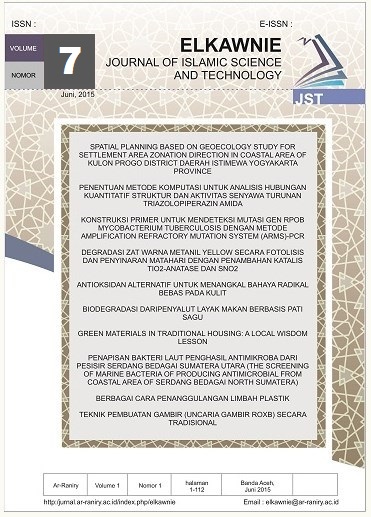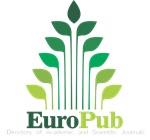Evaluation of Antioxidant Activities From Ethyl Acetate Fraction of Curry Leaf Using DPPH Method
DOI:
https://doi.org/10.22373/ekw.v7i1.8059Keywords:
Murraya koenigii, Curry Leaf, Antioxidant, DPPH, Ethyl Acetate ExtractAbstract
Abstract: Curry Plant (Murraya koenigii (Linn.) Spreng) is one of the plants that thrive in Indonesia. Curry contains secondary metabolites of alkaloids and flavonoids that have the potential as antioxidants. Antioxidants can reduce the activity of free radicals that can cause degenerative diseases such as cancer, coronary heart disease, and premature ageing of body cells by donating the protons to free radical compounds. This study aimed to determine the antioxidant activity and identify the active compound class of ethyl acetate fraction from curry leaves. Separation of secondary metabolites of ethyl acetate extracts was carried out by column chromatography method, which obtained 5 different fractions. The antioxidant activity of fractions A, B, C, D, and E was tested using the DPPH (2,2-diphenyl-1-picrylhydrazyl) method with variations concentrations of 25, 50, 100, 200, and 400 ppm, and ascorbic acid was used as a comparison which measured at a wavelength of 517 nm. The results showed that fractions A and E have weak antioxidant activities, while fractions B, C, and D showed moderate antioxidant activities. The highest antioxidant activity was found in fraction B with an IC50 value of 341.38 ppm, where the fraction showed the presence of secondary metabolites of alkaloids and terpenoids.
Abstrak: Tanaman kari ((Murraya koenigii (Linn.) Spreng) merupakan salah satu tanaman yang tersebar di Indonesia. Kari mengandung senyawa metabolit sekunder alkaloid dan flavonoid yang memiliki potensi sebagai antioksidan. Antioksidan dapat mengurangi aktivitas radikal bebas yang dapat menyebabkan penyakit degeneratif seperti kanker, penyakit jantung coroner dan penuaan sel dengan cara menyumbangkan proton pada senyawa radikal bebas. Tujuan dari penelitian ini adalah untuk menentukan aktivitas antioksidan dan mengidentifikasi kelas senyawa aktif fraksi etil asetat dari daun kari. Pemisahan metabolit sekunder dari ekstrak etil asetat dilakukan menggunakan metode kromatografi kolom dengan menghasilkan 5 fraksi yang berbeda. Aktivitas antioksidan dari fraksi A, B, C ,D ,dan E dilakukan menggunakan metode DPPH (1,1-diphenil-2-pikrilhydrazil) dengan variasi konsentrasi 25, 50, 100, 200, dan 400 ppm dan asam askorbat digunakan sebagai perbandingan yang diukur pada panjang gelombang 517 nm. Hasil menunjukkan bahwa fraksi A dan E memiliki aktivitas antioksidan yang lemah, sedangkan fraksi B, C, dan D menunjukkan aktivitas antioksidan sedang. Aktivitas antioksidan yang paling tinggi ditemukan pada fraksi B dengan IC50 341,38 ppm. Fraksi tersebut menunjukkan adanya kandungan senyawa metabolit sekunder alkaloid dan terpenoid.
References
Bhandari, P. R. (2012). Curry leaf (Murraya koenigii) or Cure leaf: Review of its curative properties. Journal of Medical Nutrition and Nutraceuticals. 1(2), 92 – 97. https://doi.org/10.4103/2278-019X.101295.
Dahlia, A. D., Islam, M. B., Zaman, S., Islam, M. A., Jalil, M. A., Ahmed, N. U., Rahim, M. A., Mondol, M. M. H., Muzahid, A. A., & Sarkar, M. A. (2017). Investigation on Phytochemical and Antioxidant Activity of the Plant Murraya Koenigii Linn (Curry leaf) in Rajshahi, Bangladesh. Journal of Antioxidant Activity, 1(2), 1-10. https://doi.org/10.14302/issn.2471-2140.jaa-17-1 728.
Fachraniah, Kurniasih, E., & Novilasi, D.T. (2012). Ekstraksi Antioksidan dari Daun Kari. Jurnal Sains dan Teknologi, 10(21), 35 – 44.
Ghasemzadeh, A., Jaafar, H. Z. E., Rahmat, A., & Devarajan. T. (2014). Evaluation of Bioactive Compounds, Pharmaceutical Quality, and Anticancer Activity of Curry Leaf (Murraya koenigii L.). Hindawi Publishing Corporation Evidence-Based Complementary and Alternative Medicine, 2014(6), 1–8. https://doi.org/10.1155/2014/873803.
Halimatussakdiah, Amna, U., & Mardina, V. (2020). Antioxidant activity of Extract of Diplazium Esculentum (Retz.) Sw. Leaves Collected from Aceh. IOP Conference Series : Materials Science and Engineering, 725 012082.
Khaira, K. (2010). Menangkal Radikal Bebas. Jurnal Saintek, 2(2), 183 – 187.
Mahipal, P., & Pawar, R.S. (2017). Nephroprotective effect of Murraya koenigii on Cyclophosphamide Induced Nephrotoxicity in Rats. Asian Pacific Journal of Tropical Medicine, 10(8), 808–812. . https://doi.org/10.1016/j.apjtm.2017.08.005
Mangkasa, M. Y., Rorong, J. A., & Wuntu, A. D. (2018). Uji Fitokimia dan Aktivitas Antioksidan dari Ekstrak Daun Bawang Kucai (Allium Tuberosum Rottl. Ex Spreng) Menggunakan Spektrofotometer UV-Vis. Pharmacon, 7(4), 12 – 22. https://doi.org/10.35799/pha.7.2018.21417
Mulangsri, D.A.K., Budiarti, A., & Saputri, E.N. (2017). Aktivitas Antioksidan Fraksi Dietileter Buah Mangga Arumanis (Mangifera indica L.) dengan Metode DPPH. Jurnal Pharmascience, 4(1), 85 – 93. http://dx.doi.org/10.20527/jps.v4i1.5760
Mustanir, Al-Qarana, T. R., Gusvianna, H., & Saidi, N. (2019). Analisa Potensi Ekstrak Daun Kari (Murraya koenigii L. Spreng). TALENTA Conference Series: Science & Technology (ST), 2, 1-9. https://doi.org/10.32734/st.v2i1.300.
Ng, R. C., Kassim, N. K., Yeap, Y. S. Y., Ee, G. C. L., Yazan, S. L., & Musa K. H. (2018). Isolation of Carbozole Alkaloids and Coumarins from Aegle marmelos and Murraya koenigii and Their Antioxidant Properties. Sains Malaysiana, 47(8), 1749-1756. http://dx.doi.org/10.17576/jsm-2018-4708-14.
Ningappa, M. B., Dhanajaya, B. L., Dinesha, R., Harsha, R. & Srinivas, L. (2010). Potent Antibacterial Property of APC Protein from Curry Leaves (Murraya koenigii L.). Food Chem, 118(3), 747–750. https://doi.org/10.1016/j.foodchem.2009.05.059.
Nugroho, Abdi, Y., & Kusnadi, J. (2015). Aplikasi Kulit Manggis (Garcinia Mangostana L.) sebagai Sumber Antioksidan pada Es Krim. Jurnal Pangan Dan Agroindustri, 3(4), 1263–127.
Patil, R. (2018). Anti-Inflammatory Activity of Alkaloids from Murraya Koenigii Leaves in Animal Models . International Journal of Latest Research in Science and Technology, 4(8), 635-644. https://doi.org/10.32628/IJSRST184872
Rahayu, Ningsih, S., Nehru, F. G., Halimatussakdiah, & Amna, U. (2019). Free Radical Scavenging Activity of Methanolic Extract of Temurui (Murraya koenigii L. Spreng). IOP Conference Series: Earth and Environmental Science. 364 012024.
Safrizal, A., Razali, Ismail, Ferasyi, T. R., Nurliana, & Masyitha, D. (2017). Effect of Curry Leaf (Murraya koenigii) Extract to Early Spoilage of Beef. Jurnal Medika Veterinaria, 11(2), 82–87.
Salwe, K. J., Mirunalini, R., Mano, J., & Manimekalai, K. (2017).
Hepatoprotective and antioxidant activity of Murraya koenigii Leaves
Extract Against Paracetamol Induced Hepatotoxicity in Rats. International Journal of Basic & Clinical Pharmacology, 6(6), 1274-1281. http://dx.doi.org/10.18203/2319-2003.ijbcp20172044.
Samanta, S. K., Kandimalla, R., Gogoi, B., Dutta, K. N., Choudhury, P., Deb, P. K., Devi, R., Pal, B. C., & Talukdar, N.C. (2018). Phytochemical Portfolio and Anticancer Activity of Murraya koenigii and its Primary Active Component, Mahanine. Pharmacolgy Reseach, 129(1), 227-236. https://doi.org/10.1016/j.phrs.2017.11.024.
Tan, S. P., Ali. A. M., Nafiah, M. A., Amna, U., Ramli, S. A., & Ahmad, K. 2017. Terpenes and Phenolic Coumpound of Murraya koenigii. Chemical of Natural Compound, 53(5), 980-981. https://doi.org/10.1007/s10600-017-2177-y
Wati, M., Erwin, & Tarigan, D. (2017). Isolasi dan Identifikasi Senyawa Metabolit Sekunder dari Fraksi Etil Asetat pada Daun Berwarna Merah Pucuk Merah (Syzygium myrtifilium Walp.). Jurnal Kimia Mulawarman, 14(2), 100 – 106.
Widayanti, A., Srifiana, Y., & Efendi K. (2019). Antidiabetic Activity of Koja Bay (Murraya koenigii) Leaves Tea Bag. Pharmaceutical Science and Research, 6(2), 107-110. https://doi.org/10.7454/psr.v6i2.4172.
Downloads
Published
Issue
Section
License
Proposed Policy for Journals That Offer Open Access Authors who publish with the Elkawnie journal agree to the following terms:
a. Authors retain copyright and grant the journal right of first publication with the work simultaneously licensed under a Creative Commons Attribution License that allows others to share the work with an acknowledgement of the work's authorship and initial publication in this journal.
b. Authors are able to enter into separate, additional contractual arrangements for the non-exclusive distribution of the journal's published version of the work (e.g., post it to an institutional repository or publish it in a book), with an acknowledgement of its initial publication in this journal.
c. Authors are permitted and encouraged to post their work online (e.g., in institutional repositories or on their website) prior to and during the submission process, as it can lead to productive exchanges, as well as earlier and greater citation of published work (see The Effect of Open Access).

























